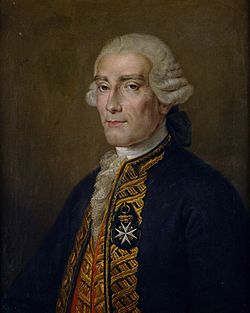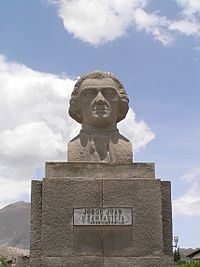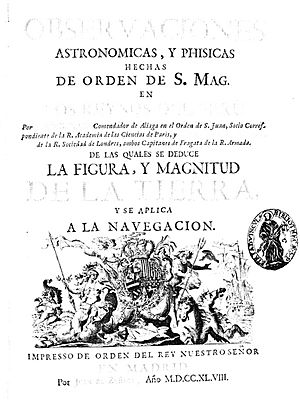Jorge Juan y Santacilia facts for kids
Quick facts for kids
Jorge Juan y Santacilia
|
|
|---|---|

Portrait by Rafael Tegeo
|
|
| Born | 5 January 1713 Novelda, Spain
|
| Died | 21 June 1773 (aged 60) Madrid, Spain
|
| Nationality | Spanish |
| Scientific career | |
| Fields | Mathematics Astronomy |
| Military service | |
| Allegiance | |
| Branch/service | Spanish Navy |
| Rank | Captain |
| Battles/wars | Conquest of Oran Battle of Bitonto |
Jorge Juan y Santacilia (born in Novelda, Alicante, on January 5, 1713 – died in Madrid on June 21, 1773) was a smart Spanish person who worked as a mathematician, scientist, and naval officer. He is famous for figuring out that the Earth isn't a perfect ball. Instead, it's a bit flattened at the North and South Poles, like a squashed orange. He also used a special tool called a barometer to measure the heights of the Andes mountains.
Contents
Early Life and Education
Jorge Juan was born in a place called Fondonet, which belonged to his grandfather in Novelda, Alicante, Spain. He was baptized in a church in Monforte del Cid. His parents came from important families. His father, Bernardo Juan y Canicia, was related to the Counts of Peñalba. His mother, Violante Santacilia y Soler de Cornellá, came from a well-known family that owned land in Elche.
When Jorge was only three years old, his father passed away. He was then looked after by the Jesuits at their school in Alicante. Later, his uncle, Antonio Juan, who was a church official, took over his education. Another uncle, Cipriano Juan, who was a Knight of the Order of Malta, then sent him to Zaragoza to prepare for higher studies.
At 12, Jorge went to Malta to join the Order of Malta. The next year, he became a special helper to the Grand Master, Antonio Manuel de Villena. He was given the title of Commander of Aliaga in Aragón when he was just 14. Soon after, he became a Knight of the Order of Malta, which meant he would not marry.
In 1729, at 16, he returned to Spain. He wanted to join the Royal Company of Marine Guards, which was a military school for naval officers. He started there in 1730. He studied many modern and scientific subjects like geometry (the study of shapes), trigonometry (the study of triangles), astronomy (the study of stars and planets), navigation (how to steer ships), hydrography (mapping water areas), and cartography (making maps). He also learned drawing, music, and dancing. He was such a good student that his friends called him Euclid, after a famous ancient Greek mathematician. He finished his studies in 1734. When he was only 22, he was put in charge of a small warship called a corvette. He took part in a military trip against Oran and a battle in Naples.
Important Work and Discoveries

In 1734, King Philip V of Spain asked Jorge Juan and another scientist, Antonio de Ulloa, to join a special trip. This trip was called the French Geodesic Mission. It was organized by the French Academy of Sciences. The main goal was to measure the length of a degree of the meridian arc at the Equator in South America. This would help them figure out the exact shape of the Earth.
On May 26, 1735, they left Spain. Jorge Juan sailed on a ship called El Conquistador. The expedition went to Quito, which is now in Ecuador. After nine years of careful study, they confirmed that the Earth is not a perfect sphere. It is actually an oblate spheroid, meaning it's a bit flattened at the poles. Jorge Juan also successfully measured the heights of the Andes mountains using a barometer.
Jorge Juan stayed in America for nine years. He studied the local politics and how people lived in the Spanish territories. He also saw a new metal that miners called Platina de Pinto (which meant "little silver from the Pinto river"). This metal is now known as Platinum. When he returned to Spain, King Ferdinand made him a captain. Because of their important work in Peru, both Jorge Juan and Antonio de Ulloa became Fellows of the Royal Society in 1749.
Later, a Spanish leader named Marques de la Ensenada asked Juan to travel to England in secret. His mission was to learn about new ways the British built their navy ships and weapons. In 1749, he went to England pretending to be someone else, using the name Mr. Josues. He learned as much as he could and sent secret messages back to Spain using a special code. He brought back 50 British shipbuilders. Interestingly, many of these builders later helped construct Spanish ships that fought in the American Revolutionary War and the battle of Trafalgar.
Jorge Juan was not fully impressed with the English shipbuilding methods. When he returned to Spain in 1750, he was put in charge of Spanish naval construction. He created his own system for building ships, which was approved in 1752. He also improved shipyards in places like Cartagena, Cádiz, Ferrol, and Havana. He made sure that different parts of shipbuilding, like dry-docks, furnaces, and making sails, were organized efficiently.
In 1757, he started the Royal Astronomical Observatory of Madrid, which is a place for studying stars and planets.
Jorge Juan died in Madrid in 1773 when he was 60 years old. He was buried in the church of San Martín. A Spanish Navy ship, the Jorge Juan, was named after him to honor his contributions.
Written Works
Jorge Juan wrote several important books:
- Compendio de navegación (1757) – A guide to navigation.
- Examen marítimo teórico-práctico (1771) – A book about naval theory and practice.
- Estado de la astronomía en Europa (1774) – About the state of astronomy in Europe.
Works with Antonio de Ulloa
He also wrote books with his fellow scientist Antonio de Ulloa:
- Plan del camino de Quito al río Esmeraldas, según las observaciones astronómicas de Jorge Juan y Antonio de Ulloa (1736–1742) – A plan of the road from Quito to the Esmeraldas river.
- Observaciones astronómicas y físicas hechas en los Reinos del Perú (Madrid, 1748) – Astronomical and physical observations made in Peru.
- Relación histórica del viaje hecho de orden de su Majestad a la América Meridional (Madrid, 1748) – A historical account of their journey to South America.
- Disertación Histórica y Geográfica sobre el Meridiano de Demarcación entre los dominios de España y Portugal (1749) – A historical and geographical discussion about the line that divided Spanish and Portuguese lands.
- Noticias Secretas de América, sobre el estado naval, militar y político del Perú y provincia de Quito (1748) – Secret news about America, discussing the navy, military, and politics of Peru and Quito. This book was published in London in 1826 after the Spanish government had banned it.
See also
 In Spanish: Jorge Juan para niños
In Spanish: Jorge Juan para niños


